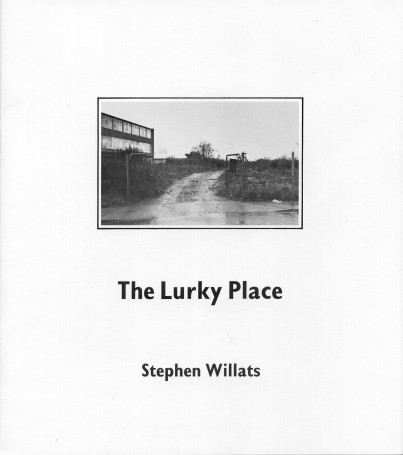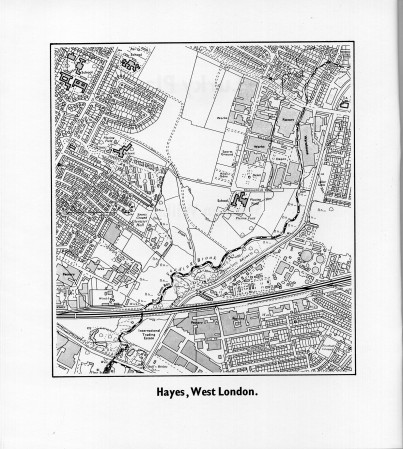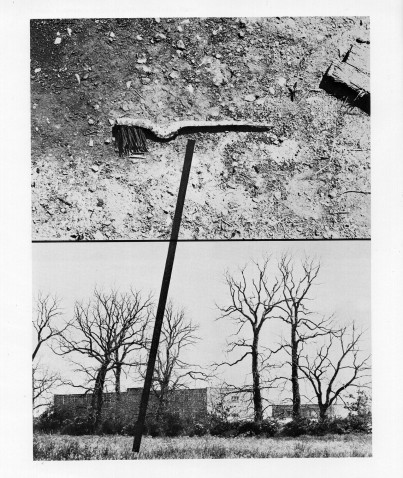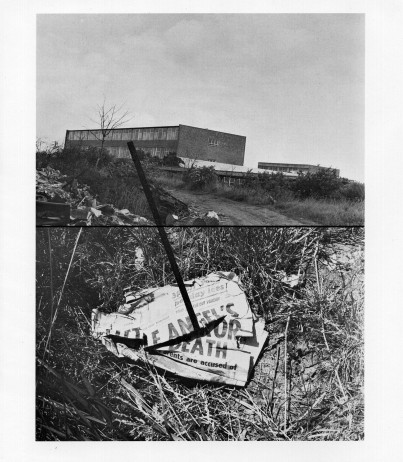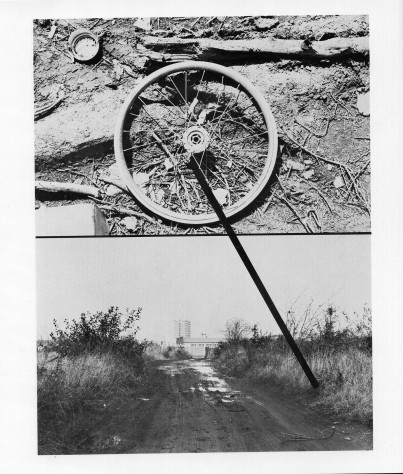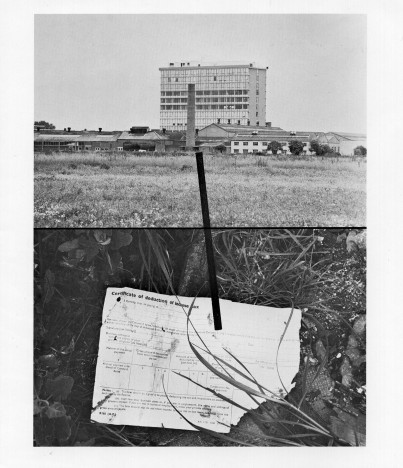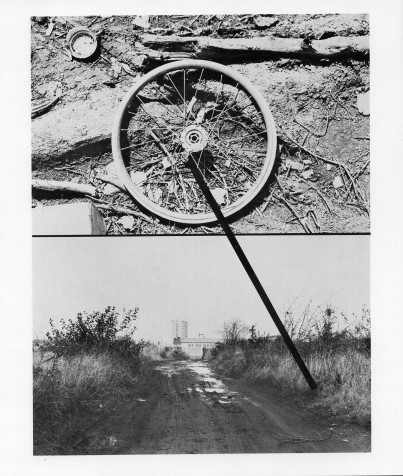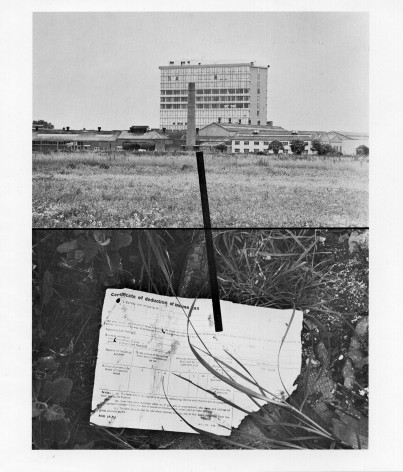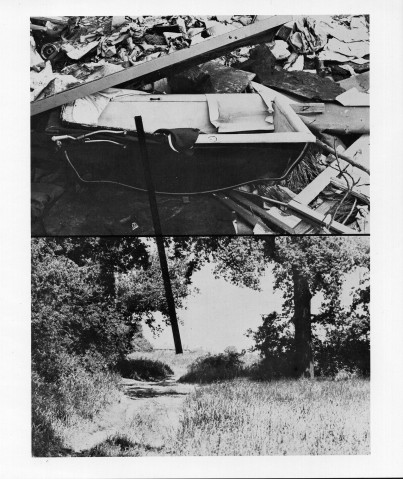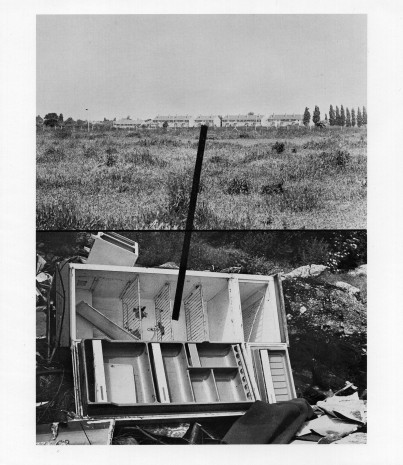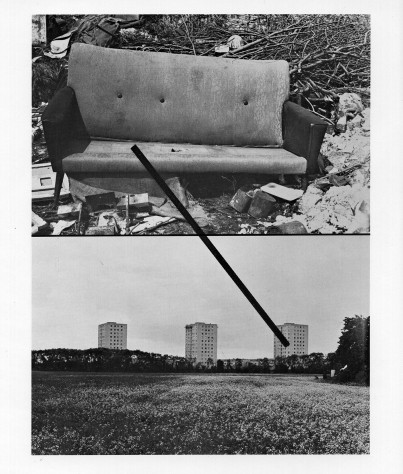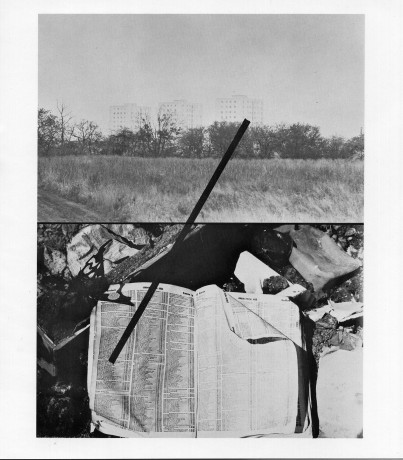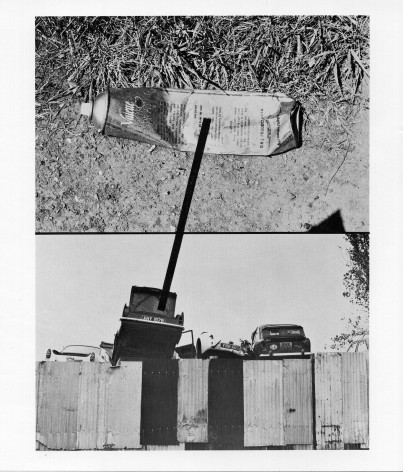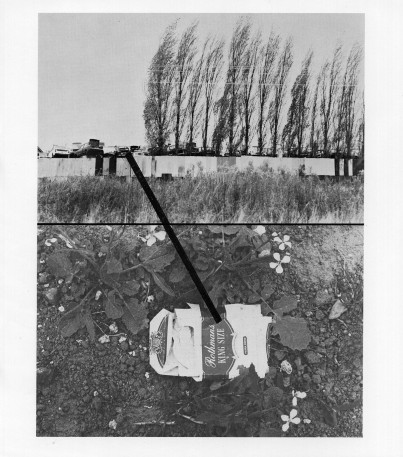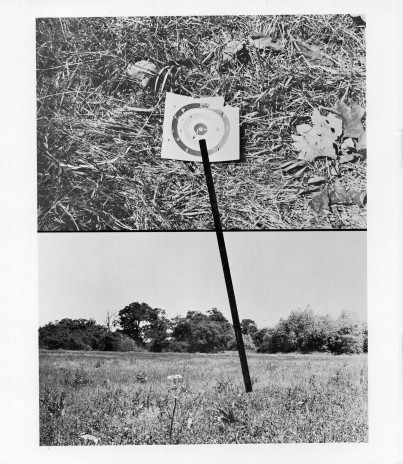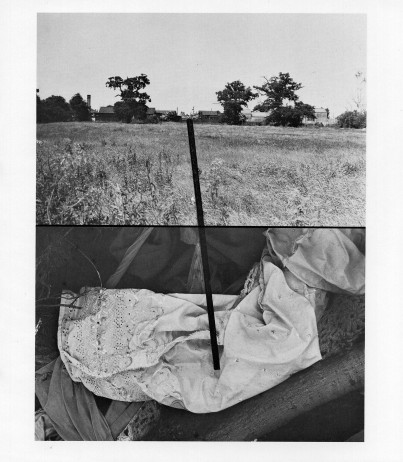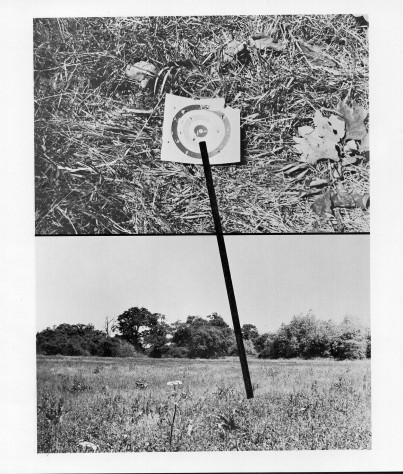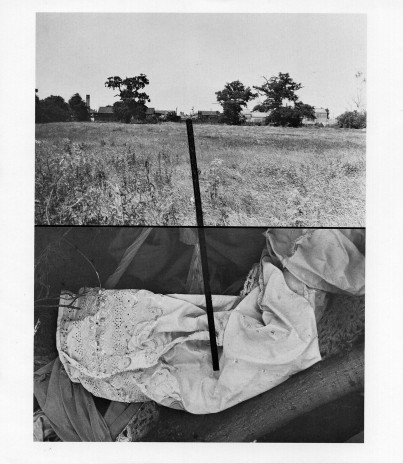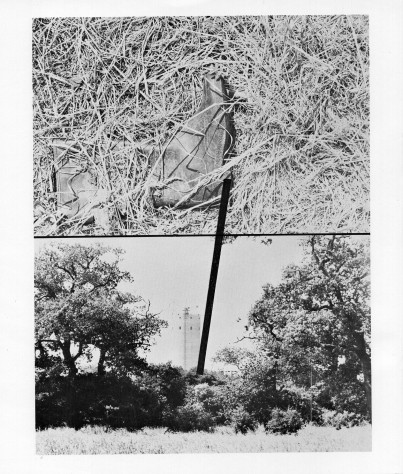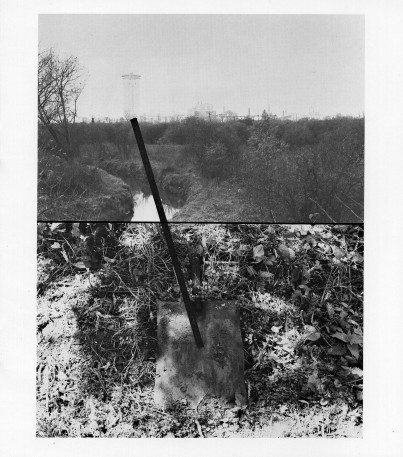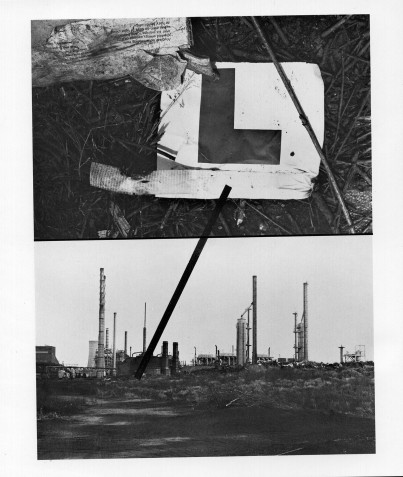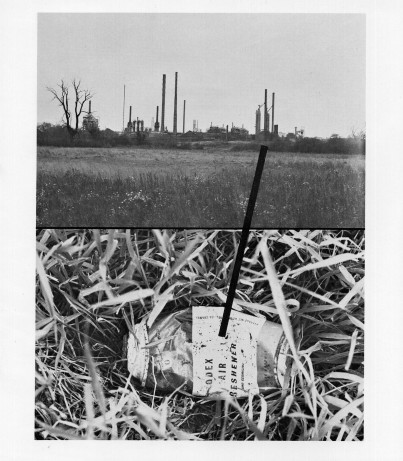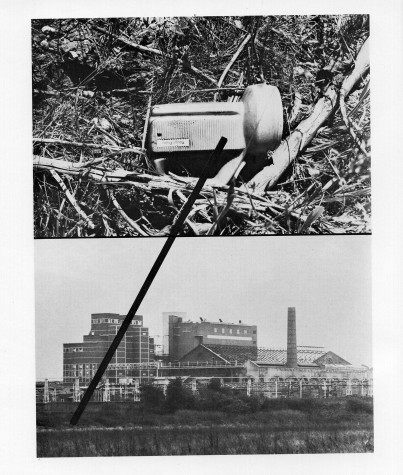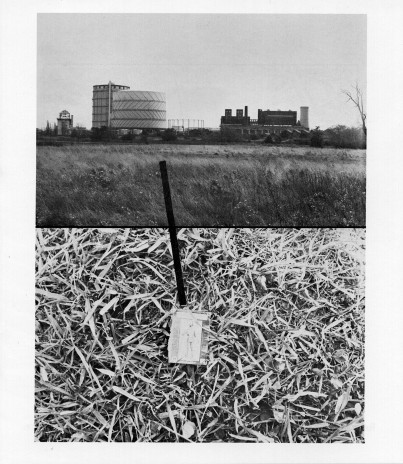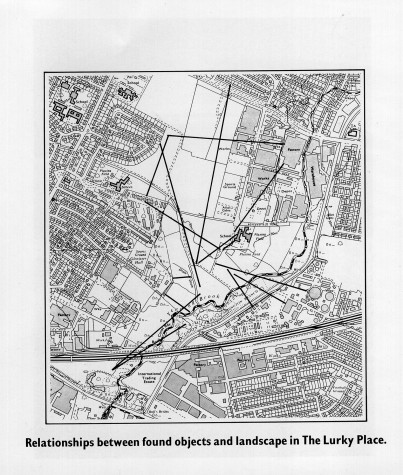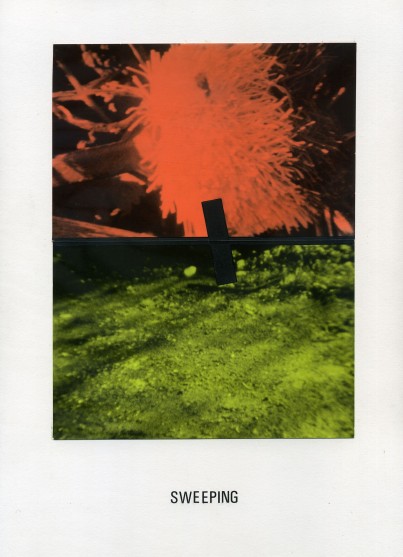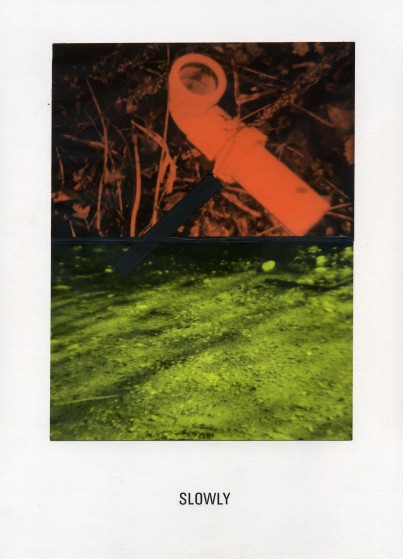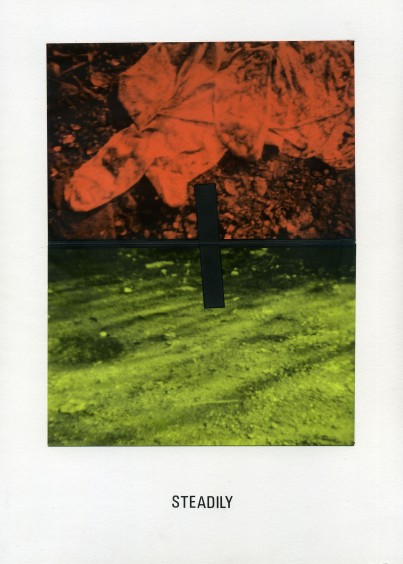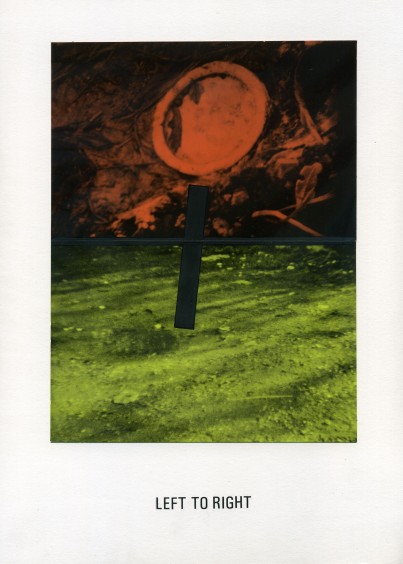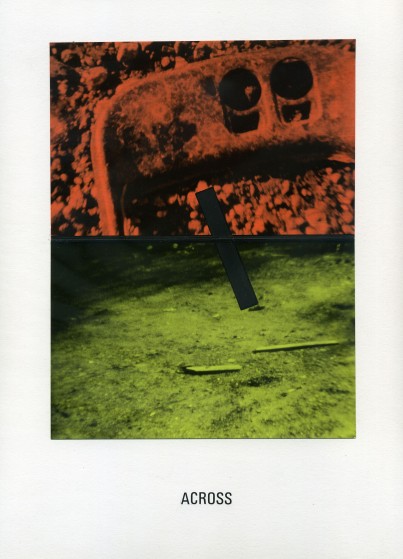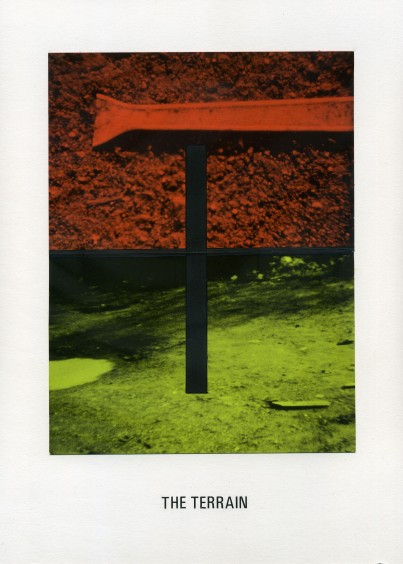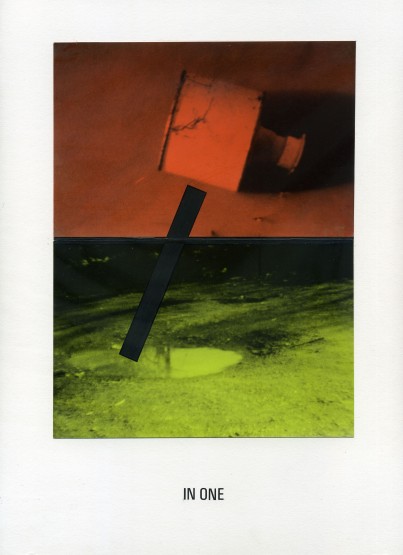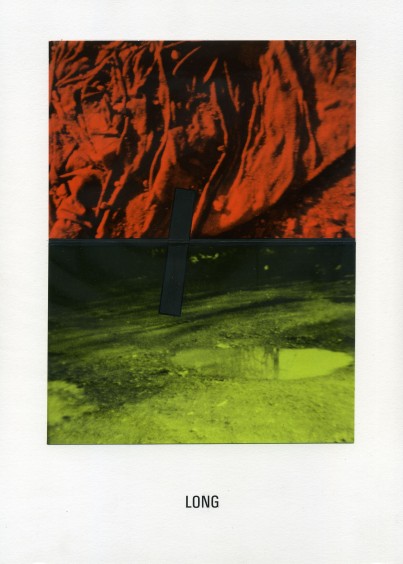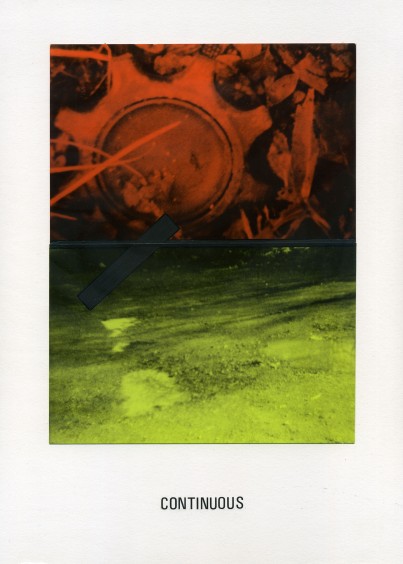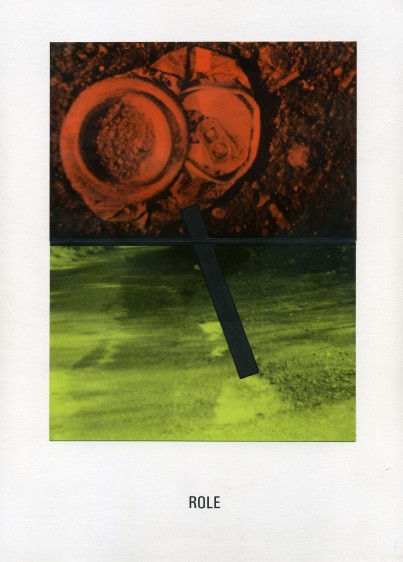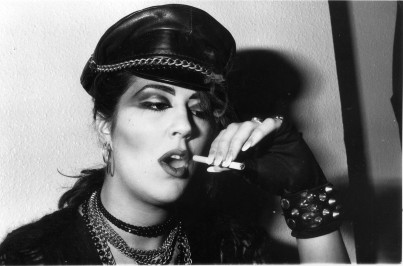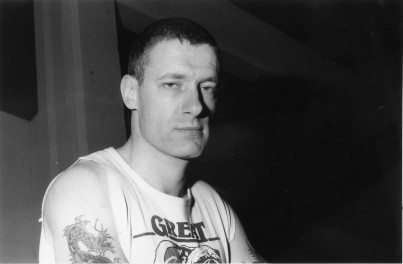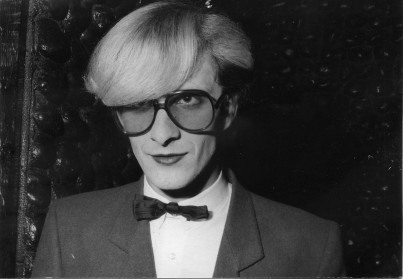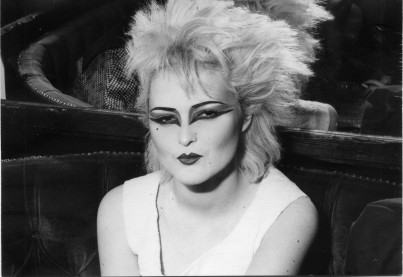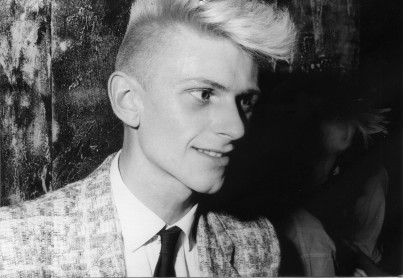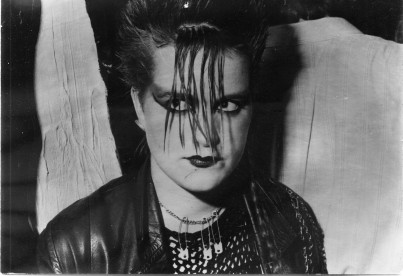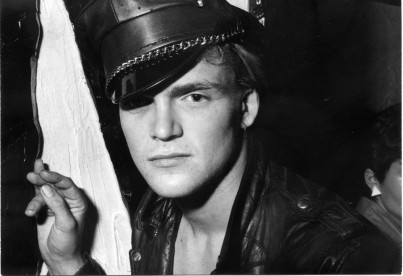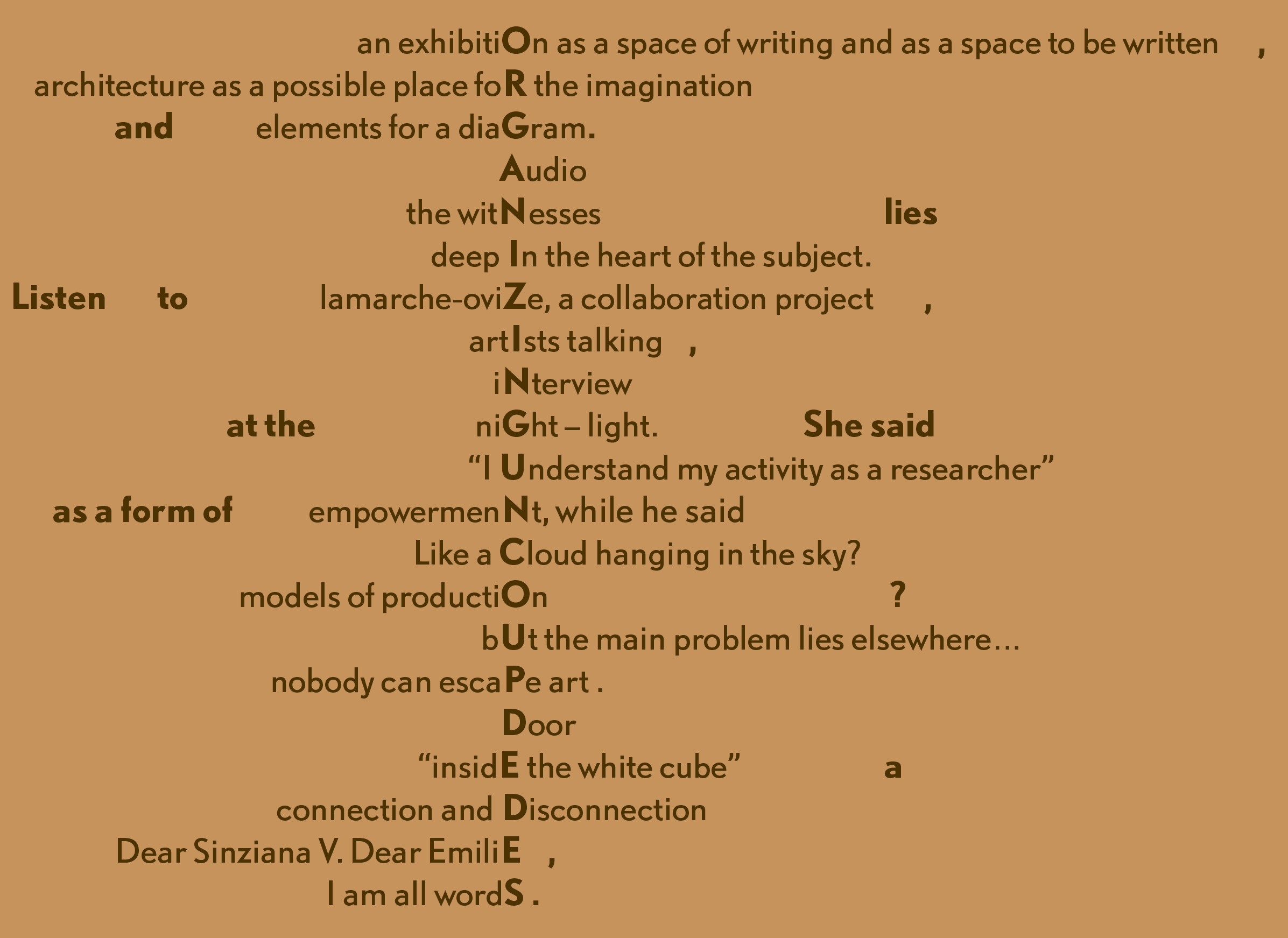The experiment of the margins
In the outskirts of Paris where urban and rural zones overlap, the CPIF is developing experimentation projects that overflow the essentialist approach of the photographic medium. Through theorist and artist invitations, the CPIF approaches photography not as an isolated, autonomous practice, but from one of those expanded fields that contemporary art represents. This is shown by the filmed interview between Joana Neves and Jesus Alberto Benitez, for whom photography is a drawing tool, as well as Chantal Pontbriand’s text on three works by Stephen Willats, who explores the photography-margins relationship by opening a space, the “photozone”.
readImpromptu
An interview between Joana Neves and Jesus Alberto Benitez
Three projects by Stephen Willats
Slide show
Click on the image to launch the slide show
The Lurky Place, 1978.
Each panel 25.5 x 20.5 cm
Courtesy the artist and Victoria Miro Gallery, London.
Copyright: Stephen Willats.
Down At The End, 1998/2000.
Ten panels from twelve panel work, with 8mm film.
Panels one and panels twelve 22cm wide x 72cm high, Panels two through to eleven each 22cm wide x 30cm high.
Photographic prints, photographic dye, acrylic paint, Letraset text on card. Standard 8mm black and white film, apron 3 minutes.
Courtesy the artist and Victoria Miro Gallery, London.
Copyright: Stephen Willats.
The Night People, 1982.
Each postcard 10 x 15 cm.
Courtesy the artist and Victoria Miro Gallery, London.
Copyright: Stephen Willats.
Photography and the Margins
On three projects by Stephen Willats
by Chantal Pontbriand
Since the 1960s Stephen Willats has been exploring a unique and novel approach to art and photography. His work aims to develop new modes of behaviour and cognition.
These give rise to a creative œuvre in the social field within the framework of a “dispositif” put in place by the artist. He has been particularly interested in situations on the margins of urban life, where photography, in addition to texts and drawings, plays an important role. His conceptual although materialist devices aim to put in place systems or interactive analysis linked to cybernetics and theories of learning.
Stephen Willats’s work appears to me to belong to the concept of photozone, a term I use to qualify the type of interface between space and the photographic apparatus. Photozone outlines what is specific to photographic space: either the zone in its globality or designated by photography. The zone in question can either be a real space or a mental space and it explores the many registers which qualify one or the other. What is meant by real space, is a tangible space which lends itself to an observation, an action or an intervention. Mental space does not just represent tangible space; it is invaded, permeated or even transmuted by it. Hence our preference for the word tangible rather than physical. Being tangible refers to touch, tactility and contact. Mental space’s tactility communicates with real space and conversely real space reveals itself through what is tactile. A world view which would be solely physical refers to an objectivity which withdraws part of its value and its interest. The concept of zone allows us therefore to qualify continuity, indeed the reciprocity and connectivity which exists between the real and the mental.
Tangible comes from the latin tangibilis, which means « can be touched, palpable ». It refers to the potential of existence rather than a fixed reality, immutable such as the physical world would have one believe. The intangible, on the other hand, indicates what is immutable and is supposed to remain intact. However, the world is far from being immutable. Rather it is in perpetual flux and in that sense it resembles the world of the imagination which ceaselessly transforms itself. A photozone designates both the tendencies and anchorage, particularly of these real and mental spaces as well as their reciprocal tactility. In relation to the concept of photozone, the photographic apparatus itself is the tool which allows one to capture this zone of tangibility, the capacity to be recognised due to the fact it is palpable. Throughout the centuries this mechanism has changed and the full scale of this spectrum can be grasped just by mentally listing the diverse forms it has adopted from the camera obscura to digital photography.
Simply in broaching the topic of this first and last embodiment, one notes the strong indications of tactility in those two examples, which are situated at either end of the history of the technique and the medium. The tangibility of the camera obscura resides in the fact that it is situated in the space of the image itself. Its mechanical apparatus is located within real space at the point where the photographed space and the « machine » which creates the image are only a few metres apart. In this instance the camera even comprises its own apparatus to reveal the real image that it seeks to produce. The same applies to digital photography which includes in its mechanical apparatus the immediate transmission of the photographed image. In both cases the continuity which constitutes the choice of a real space, the setting up of an apparatus to capture it and then the result as an image in their very instantaneousness, their co-existence in time and space denotes a heightened indication of tactility due to reciprocal tangibility.
However, beyond this effect which can be qualified here as primary and, which alongside the development of technology and artistic approaches and practices, became a lot more complex, photography gives rise to many sensitive zones which increase the knowledge we can acquire about the interface between mental and real space. Real spaces are «exposed » and appear in a different light whereas photography frames and reframes, adjusts the brightness, the texture, the colours and the produced image extracts the reality from the real and in doing so roots out new, sensitive and often unsuspected realities. The daily or mundane experience of a place, even of a situation is confronted by the image, the site of cognition and new knowledge.
The question of photography as an apparatus of inquiry looms. Photography is linked to the tangible and in this sense can be considered to be a proof of reality. However, the current usage of the medium greatly exceeds this quality in so far as we can catch a glimpse of it and in so far as it is used in different so-called legal and scientific procedures. Art deals with the domain of reality in photography but not so much to yield proof of the tangible, of tangible reality or some kind of inquiry but to test what is real. In this sense the photozone, the zone which belongs to photography, increasingly proceeds from quest to inquiry and its aims are not so much deterministic as inventive. The inquiry seeks within an observable situation, the quest would seek rather to supersede it, to move beyond the expected and even the visible in its relative immediacy. Concerned with research rather than by the verification of established parameters, the photozone is a free zone of observation and contact which produces uncommon results. Here our concern is not with producing tangible proof of facts but to create a new fact, an event which adds to knowledge. At the very least one which arouses desire and interest. Thus, a greater and wider vision of the world is created.
The three projects by Stephen Willats accompanying this text are in this sense photozones. Each of these projects explores different directions adopted in Willats’s work, based on several books, such as The Artist As An Instigator of Changes in Social Cognition and Behaviour 1, which dates from 1973. In the latter he explains how the artist can instigate change in the social sphere. His approach aims from the outset to reconsider the artistic process itself in order to develop new approaches, no longer centred on the object, which are informed by cybernetics, theories of learning and about advertising. He has been interested in systems comprising autonomous modes of organisation and in philosophical ideas arising from these modes, such as fluidity, the transitory, relativity and complexity as well as in the notion of the interactive interface. He insists that a work of art is a product of society – and that the artist plays the role of instigator in it.
In particular, his work consists in modifying perceptions, knowledge of oneself and one’s environment. The audience (we should note that Willats considers that those interested in his work are different to spectators or visitors. They are rather an «actively listening audience ».) is part of the sphere of action which arises from parameters, games, rules that are applied universally and are accepted in advance by interested parties. This sphere of action unites the social and the artistic in a visual interface stemming from research procedures based on investigation. Willats has carried out different projects in various areas of London, permitting him to elaborate and refine his research. Although photography may have played an important role in the elaboration and establishment of procedures which form the basis of different projects, here we will focus rather on the works contained in the portfolio of images which are available on the following pages of this website.
In 1978 the artist published a book with the Lisson Gallery, The Lurky Place Book, comprised of a certain number of photographic plates, diptychs which portray a general view of a place and a close-up which shows in detail an object found in this place. The Lurky Place is located at the edge of the city in an industrial estate. At the time it was in fact a wasteland. The inhabitants in the surrounding area were fond of this place. The objects found there are a testimony to particular practices in this place, nevertheless not designed or organised as a public space and difficult to access. These objects are evidence, revealing a social and economic environment. A closer look allows us to obtain a more complex vision than just a wasteland. The view that comes first to mind appears to be one just like any other wasteland but through the close-ups of the objects, it becomes a socially inhabited place, a place where the communal occurs and which indicates in the last resort life forms about which the economic environment is hardly concerned. Behaviour and habits are highlighted and give an unusual meaning to this place. All the diptychs produced by Willats are linked by a black stroke which connects the found object to its environment.
Thus comments Stephen Willats on the visual procedures he establishes in the series:
The value it has for residents of surrounding housing estates is as a symbol of a consciousness which is counter to that of the predominant social stereotypes. The way peoples’ destinies are largely determined by the dulling routines of their daily lives is contrasted with the freedom of pursuits and interests carried out within The Lurky Place. Elements of this freedom are transported from the constraints of our dominant culture and discarded in The Lurky Place, in the course of engaging in these various pursuits. Through these residual items, it is possible to structure connections between the consciousness vested in The Lurky Place and the restrictive society in which they originated 2.
The series Down At The End (2001) grows on those principles. Graphically, this series appears to be less of a documentary than the previous one and has an effect on the consciousness, which is doubtlessly more dream-like. The black strokes which link the elements in each of the colour diptychs are emphasised and play with the pictoral tradition, reminiscent of suprematism, which has been revived in the history of advertising and in whose language Willats has been deeply interested. The visual consciousness is vested with the graphic quality of images which communicate their content on a sensorial level and renders to the image something of the tactile substance of the environment from whence those photographs have been « extracted ». Thus the images convey a heightened sense of reality.
The Night People is an unpublished postcard project from 1982 originally conceived for the Westkunst exhibition. Willats photographed people at night and was interested in the unusual nature of their dressing habits, make-up and behaviour in a nocturnal context. These peculiar portraits are reminiscent of Giorgio Agamben’s book, La Communauté qui vient 3, where he attempts to define what is « the whatever being». Here, in these photographs the peculiar, specific detail is what is sought. The night people exists and acts outside the norms, the rules and conformity of daytime. Here, Willats appears to be telling us through these amazing images that the people exists.
Willats is interested in the margins of existence and the micro-tales that develop there (in contrast to the meta-tales which create the great narratives and their political, economic institutions). He activates cognitive devices and change in the consciousness of the viewer which nowadays seem more necessary than ever and he achieves this by decentering the look and the relations. The inventive and imaginary potential, located in the margins, confirm this « decentering » as a quality 4.
Further reading:
Centre Photographique d’Île-de-France
Jesus Alberto Benitez
Joana Neves
Stephen Willats
Chantal Pontbriand
Notes:
- Stephen Willats, The Artist As An Instigator of Changes in Social Cognition and Behaviour, Occasional Papers, 2010. ↩
- Stephen Willats, The Lurky Place Book, http://stephenwillats.com/work/lurky-place/. ↩
- Giorgio Agamben, The Coming Community (Theory Out of Bounds), University of Minnesota Press, 1993. ↩
- See the following publications from authors who have recently researched ideas similar to Willat’s: Franco Bifo Berardi, The Uprising, On Poetry and Finance, Semiotext(e), 2012, and Bruno Latour, Enquête sur les modes d’existence, une anthropologie des modernes, La Découverte, 2012. ↩
Special
Issues
EDITO
ORGANIZING UN COUP DE DÉS
, and lies listen to,, at the she said as a form of, while he said ? . a , .
For the summer edition of uncoupdedés.net magazine, I have let myself be inspired by Mallarme´s dice play to shift away from a regular textual introduction. In favor of the actual produced material and the heterogonous spirit I found in the magazine, I limited myself to use what is already existing – titles and content – to produce a minimal intervention: , and lies listen to,, at the, she said, as a for of, while he said ? . a , . The economy of words deploys a visual and musical dimension of the assemblage, flames the collective effort, fulfills magical strategies, provokes memorization or, perhaps, simply incorporates the fundamental action given by this invitation: ORGANIZING UN COUP DE DÉS.
Manuela Moscoso
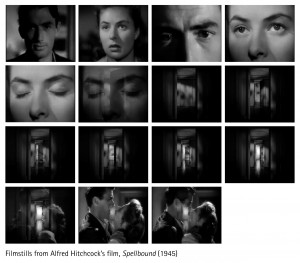
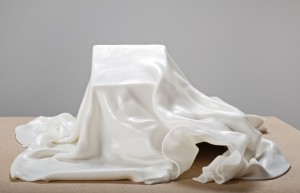
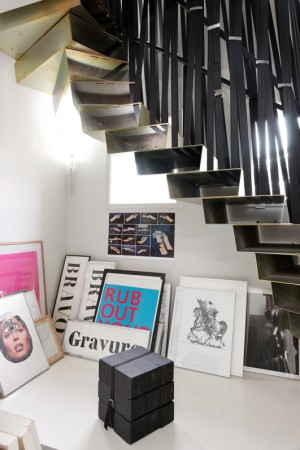
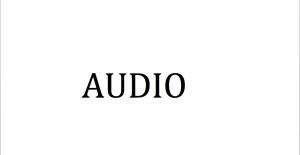

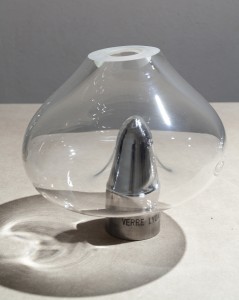
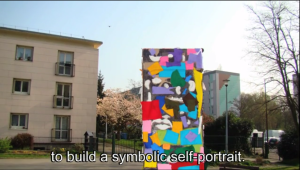

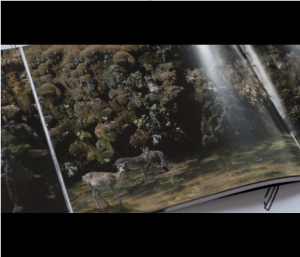
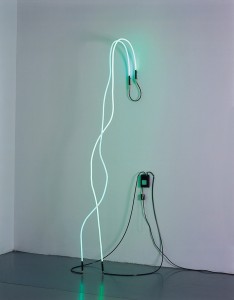
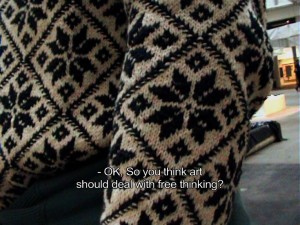
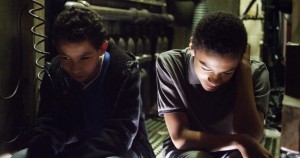
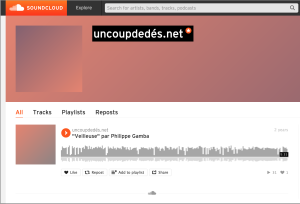
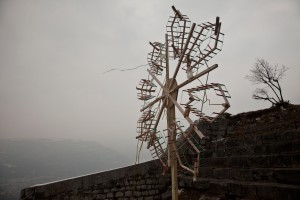
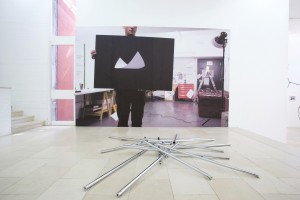
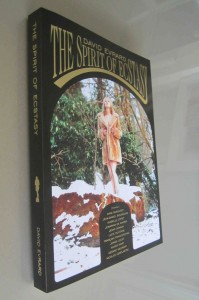
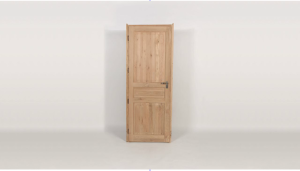
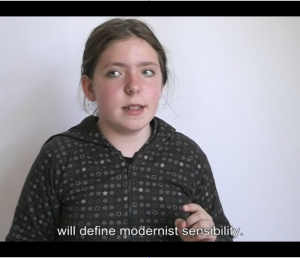
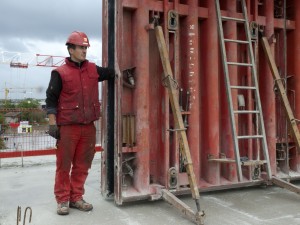
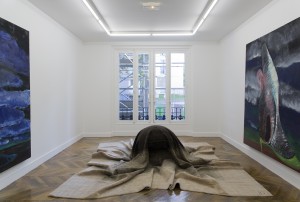
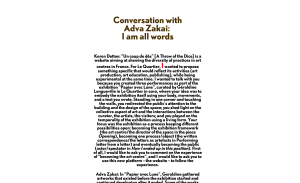
CONTENTS
ABOUT
Bolstered by its success and visibility, uncoupdedés.net is restarting and subjecting existing content to new voices. In 2014 and 2015, several personalities from outside France will be asked to become our editorial writers for one season. Their task will be to place the contents of the whole magazine in perspective, presenting them differently through the prism of their subjectivity and their own work contexts. Catalina Lozano (Colombia), Zasha Colah (India), Moe Satt (Myanmar) and Manuela Moscoso (Brazil): each guest editor will reformulate the actions of the centres d’art, various aspects of which they will have been able to perceive through the magazine. Each editor-in-chief will “roll off” a cross-cutting text, presenting an original re-examination of the resolutely fluid geography of the centres d’art. uncoupdedés.net repeats the challenge from the poet Mallarmé, resurrected in the cinematographic art of Jean-Marie Straub and Danièle Huillet (Every Revolution is a Roll of the Dice, 1977). The guest editors, coming from a variety of disciplines, will widen the circle of expression even more. Choral and fragmentary, uncoupdedés.net takes just as much after puzzles as it does after memories, and naturally calls for cut-outs of every kind…
•
MANUELA MOSCOSO
(Sao Paulo, Brazil)
Manuela Moscoso is a Brazil-based curator. Recently she has curated 12 Bienal de Cuenca, Ecuador; Yael Davis in the Museo de Arte do Rio Brazil; Fisicisimos, Universidad Torcuato di Tella,The Queens Biennale in the Queens Museum New York; or Before Everything in CA2M (Madrid). Together with Sarah Demeuse is Rivet, a curatorial office investigating notions of deployment, circulation, exercise, and resonance. Their research has materialized in projects in Spain, Norway, Lebanon and the US. Manuela Moscoso holds an MA from Center for Curatorial Studies at Bard College.
